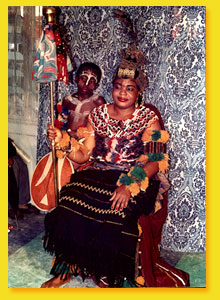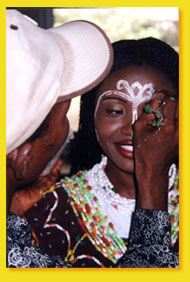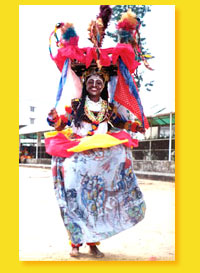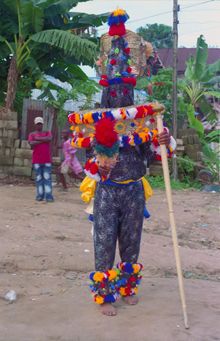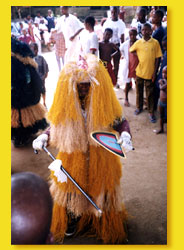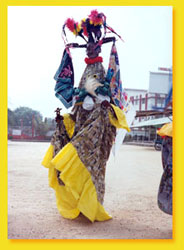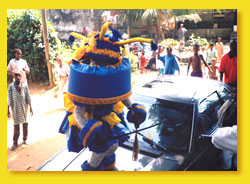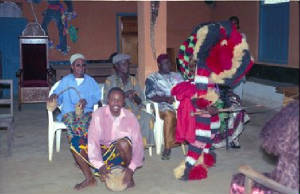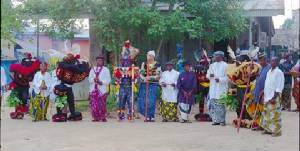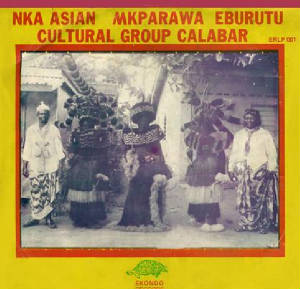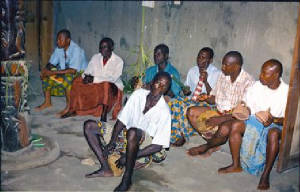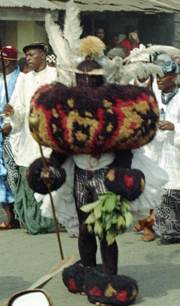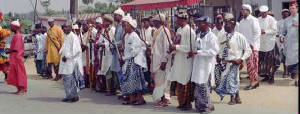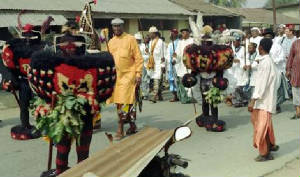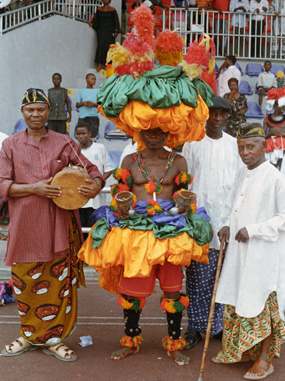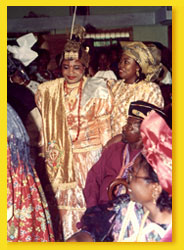|
 |
|||||||||||||||||||||||||||||||||||||||||||||||||||||||||||||||||||||||||||||||||||||||||||||||||||||||||||||||||||||||||||||||||||||||||||||||||||||||||||||||||||||||||||||||
|
The Fattening Room (Nkuho) The Fattening Room is an aged old tradition of the
Efik people of Calabar, which has been greatly modified for today's generations. This ancient tradition is the training given
to young women while they are in seclusion to prepare them for marriage and womanhood. During this period the girl is being cared for by older women and is not allowed to come in contact with
other people. She is put in a room where on a daily basis, is massaged three times, fed about six large portions of food (like
poridge ekpang, plantain, yam fufu and assorted pepper soups), drinks three pints of water three times and gets plenty of
sleep. This process ensures the bride gets a healthy waistline. According to the Efik people, they believe a woman who is
full figured with a healthy waistline is beautiful. In the Fattening Room the girl goes through domestic training of home economics (like cooking and housekeeping),
childcare and how to respect and make her husband to be and his family happy. The older women give advice about their experience
in marriage to ensure a successful one. Another important parts of Efik cultural training are the cultural dances (Ekombi), folklore, folktales,
songs and other forms of entertainment. Skills in artistic designs on Calabash and other materials are taught as well. All
this to prepare her for marriage and womanhood. At the end of the seclusion period, people all over are invited to witness the graduation ceremony to honor
her success in passing through this ordeal. This ceremony is celebrated with traditional Efik dances (Ekombi) and other forms
of entertainment. This big feast and merriment continues through out the whole day and night as families, friends and well
wishers express their joy and happiness with gifts and donations to the bride. Finally she and her future husband embraces
and dances welcoming everybody that have come to join the celebration. Everybody cheers the happy couple.
FACE & BODY PAINTING The face and
body painting with Ndom among the Efik people symbolizes purity and love. In the old days it was a form of self-expression
where personal identities or pattern were developed and recorded. These patterns came from various families and have developed
into family identities. In some occasions
the painting of face or body with Ndom is an expression of joy of birth of a child or any other good news the family might
receive. The painted face is also an indication that the bearer has been initiated into all women society. The Abang dancers
wear face painting for personal expression of beauty, femininity and love.
ABANG
DANCE The Efik people
from the Abang dance
displays beauty and femininity emphasizing on flexibility and grace. It is a dance of space, rhythm and unity that attracts
and holds the attention of the audience, giving them the appearance of lightness and balance. Lead dancers
always wear a headgear decorated with vibrant colors of red, green and yellow raffia called Ibuot Abang. Sometimes these are
decorated with bird feathers that are placed in five formations attached to the flexible stems made out of cane called Basinko
giving flexibility. Several silk
scarves and handkerchiefs are hung from the basinko for the lead dancer to hold on to for support. While the Abang
dancer bears the Ibout Abang she undergoes some degree of transformation, taking on the spiritual and physical responsibility
of representing the Ancestors or Spirits. During this time she remains silent for the duration as she carries the Ibout Abang.
As part of her
costume, her neck is adorned with elaborate colorful beads called Nkwaesit Itong. Across the shoulder she wears bright coral
beads called Anana Ubok as her arms are covered with colored raffia called Ekpaku Ubok. Her legs are also covered with raffia
and bells called Mkpat Etim. The dancer wears
around the waistline an Akasi made out of cane. This symbolizes the ideal beauty of an Efik woman full figured with a healthy
waistline. The Akasi is covered with a large piece of fabric to show beauty, femininity and grace as the dancer moves their
body.
Masquerades
Masquerades
are one of the oldest traditional and cultural events through out There are different
kinds of Masquerades for various events like the coronation of the Obong (king of Calabar), burial, Chieftency and other seasonal
celebrations and ceremonies. The most distinguished
and highest of all other masquerades is the Ekpe Masquerade. Its' members are only men and is played on special occasions.
TRADITIONAL ATTIRE The Efik traditional
attire is very elaborate and colorful. The women dress like queens and princesses wearing long flowing gowns, adorning their
necks with colorful coral beads and wearing traditional made beaded shoes. They carry beaded handbag while some wear a headdress
to match their outfit. The men wear
white shirts over a colorful wrapper tied around their waist. They also hang a long piece of cloth on their neck called Okpomkpom
in addition to beaded shoes and a cap.
ARTISTIC CULTURE The artistic
culture of the Efik people belongs mostly to the women since the are naturally artistic. The art of calabash carving and brass
carving with brasstray decoration are still a big part of the women culture. This art is being handed down to the younger
generation. Other artistic
works by the women are beadwork like beaded shoes, hand bags and the special chewing stick bag called Ekpat okok. There, is
also raffia and mat weaving basket making, woodcarving and cane making which are done by the men. |
||||||||||||||||||||||||||||||||||||||||||||||||||||||||||||||||||||||||||||||||||||||||||||||||||||||||||||||||||||||||||||||||||||||||||||||||||||||||||||||||||||||||||||||||
 |
||||||||||||||||||||||||||||||||||||||||||||||||||||||||||||||||||||||||||||||||||||||||||||||||||||||||||||||||||||||||||||||||||||||||||||||||||||||||||||||||||||||||||||||||
|
|
||||||||||||||||||||||||||||||||||||||||||||||||||||||||||||||||||||||||||||||||||||||||||||||||||||||||||||||||||||||||||||||||||||||||||||||||||||||||||||||||||||||||||||||||

